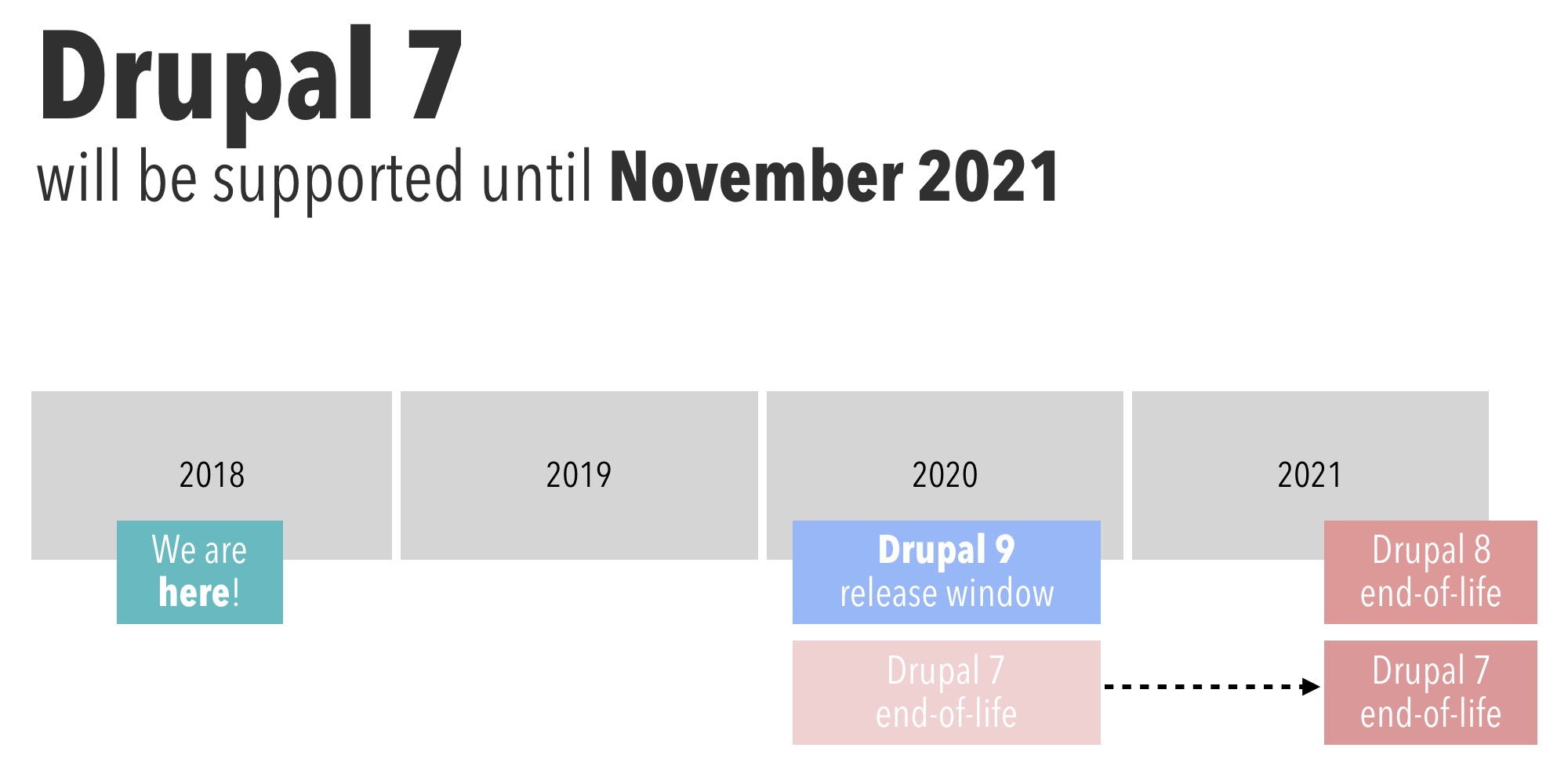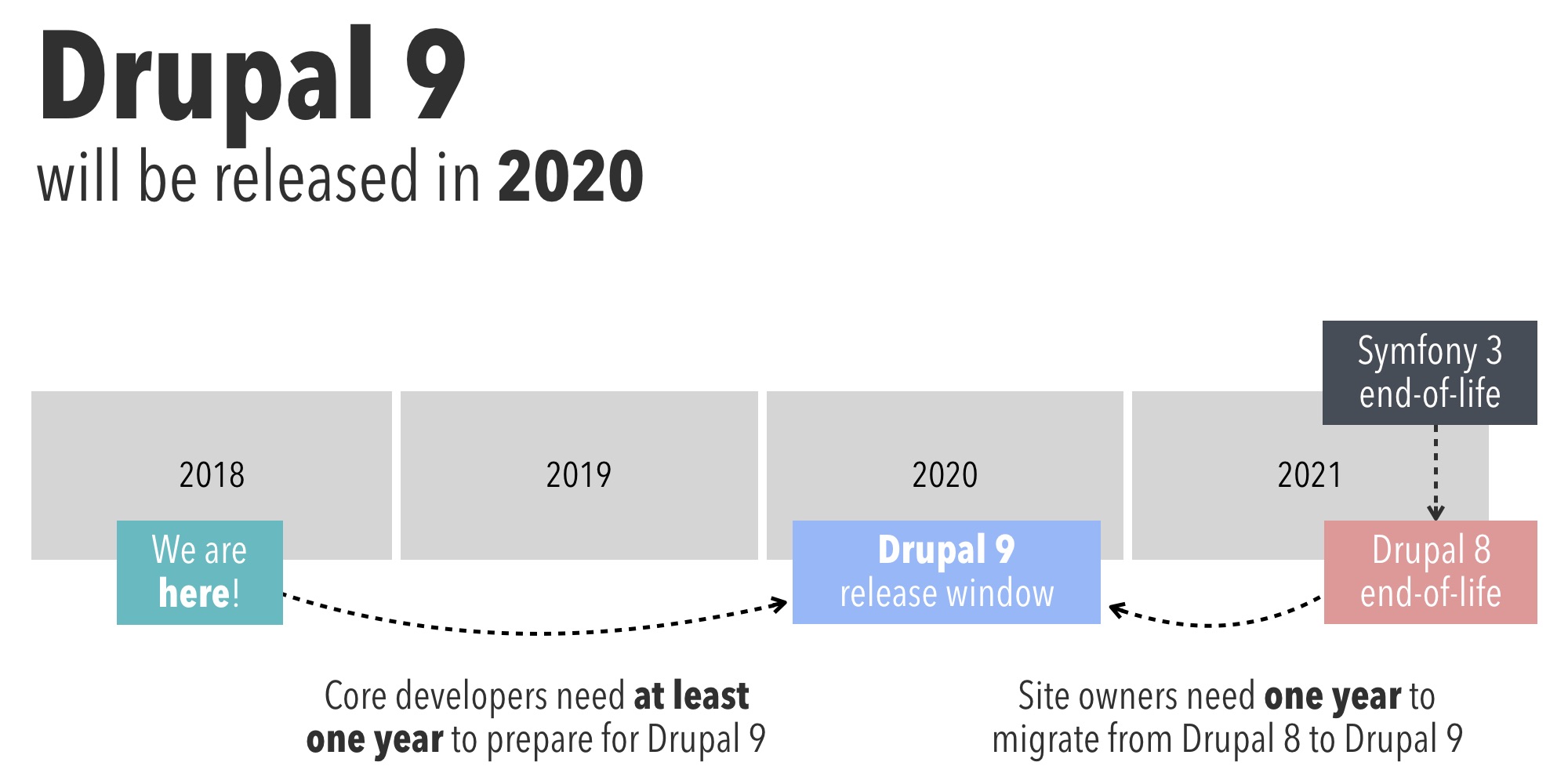When should we start thinking about moving from Drupal 7 to Drupal 9?
The short answer is: As soon as you can!
What’s happening to Drupal 7 and 8?
In late 2018, Drupal announced that versions 7 and 8 would reach end-of-life in November 2021. In order to prepare for this transition, sites currently built on Drupal 7 will need to transition to Drupal 9 or another platform by May/June 2021 (5-6 months prior to end-of-life).

Image via: https://dri.es/drupal-7-8-and-9
Drupal 8’s innovation model of “introducing new functionality in minor versions while maintaining backwards compatibility” has been successful. However, lead developer Dries Buytaert says that “instituting minor releases” to Drupal 8 is not feasible or sustainable. Drupal 8’s biggest dependency is on Symfony, a third-party library that has an end-of-life date of November 2021. And in order to maintain the security of sites built on Drupal, a Symfony upgrade will require a Drupal 9 release. This means Drupal 8 must reach end-of-life by November 2021.

Image via: https://dri.es/drupal-7-8-and-9
What do you recommend site owners do?
Drupal 7 site owners should start rebuilding on Drupal 8 immediately. Drupal 8 is available and mature. It requires a major rebuild of the platform now, but will enable an easy upgrade to Drupal 9. Moving from Drupal 8 to 9 will be a simple, routine version update.

Image via: https://dri.es/drupal-7-8-and-9
Because of the transition, we are not recommending Drupal 7 site owners make significant investments in the current platform. Instead, we recommend maintaining sites as minimally as possible and redirecting investments to developing a transition strategy and prioritizing movement off Drupal 7. We’ve developed the below sample timeline to help our partners get a sense of the best timing for planning and implementation.
Sample Timeline for Moving from Drupal 7 to Drupal 8
This sample timeline is a tool for beginning to plan and socialize your Drupal upgrade with your executive leadership and board. Because these projects are rarely one-size-fits-all, it may need to be modified to your organization’s unique needs and budget cycles.
We’ve advised organizations of all shapes and sizes on these kinds of transitions and would love to work with you. If that’s something of interest to you — get in touch.
Now - July 2019: Plan and scope your platform rebuild strategy and identify your budget
The move from Drupal 7 to Drupal 8 requires a full rebuild, so use this as an opportunity to make enhancements to your content and SEO, information architecture, user experience, visual identity and design, authoring experience, search integration, and other platform integrations. You also should consider introducing advanced functionality like custom tracking, multilingual, and personalization.
You may need to adopt a new search strategy, as Google deprecated its site search application. Open source options include Solr and Elasticsearch. Elasticsearch acquired Swiftype, which is a powerful search product we recommend that you can license for minimal cost.
Accessibility is another important consideration for planning. Web Content Accessibility Guidelines (WCAG) compliance is now required by all organizations (not just those in the public sector), in order to ensure website design is inclusive of persons with disabilities. Your website needs to be in compliance with the Americans with Disabilities Act (ADA) Standards for Accessible Design as soon as possible to avoid potential legal action for non-compliance. As part of your Drupal upgrade planning, we recommend running a WCAG audit and determining steps you need to take to be ADA-compliant with the new platform.
August - October 2019: Finalize requirements and planning for new platform and approve multi-year funding
We recommend using 2019-2020 funding to develop a full strategy and validate the scope of your design build, so you can finalize that budget for 2020. If you have the means, begin user research this year to inform your decisions.
As you budget, you’ll want to make sure you’re accounting for hosting and maintenance of your legacy site until you fully sunset it.
October - December 2019: Develop and finalize statements of work and kick-off your implementation project
If you’re on a calendar fiscal year, you’ll align the project start to the January turnover. If you’re on an April, July, or academic year cycle, you may decide to hold on the start until the fiscal year turnover.
However, for these budget cycles, we recommend allocating 2019-2020 funds to get started ahead of your new fiscal year so your timeline is not constrained.
January - May 2020: Project kickoff
You’ll kick off your project, architect your sitemap, taxonomy, site templates, authoring experience and develop an integration plan.
With this work complete, you’ll be able to validate and refine the scope and budget for your design and implementation. You’ll also be able to scope your content effort and get started with content planning, refinement, and production.
June 2020 - March 2021: Complete the visual and in-browser design and pattern library development for the site, as well as your back-end development
During this time period, you will also need to:
- Complete your content development efforts and migrate and input content into the new site
- Complete user acceptance testing and preparation for launch.
- Develop your roll-out plan and a plan for how long you’ll maintain your legacy site in archive
- Start planning and budgeting for continuous improvement — website administration, routine security updates and maintenance, and enhancements — for post-launch. Make sure to include budget for ongoing user research in this planning.
April - June 2021: Launch new site
You’ll launch your new site between major fundraising cycles so it doesn’t disrupt major ongoing initiatives. You’ll also develop statements of work for any continuous improvement work and begin that work.
July 2021 - November 2021: Make final modifications and preparations
With your site live, make any final modifications and preparations for sunsetting your legacy site. Once you no longer need to access that site in archive, discontinue hosting the site.
We hope this sample timeline is helpful to you as you plan your transition. If you’re interested in partnering with us on this work, get in touch. We’d love to work with you!
Drupal vs. WordPress?
If you’re one of the many people curious about the rationale for Drupal over WordPress or vice versa, check out our advice article on the topic.
